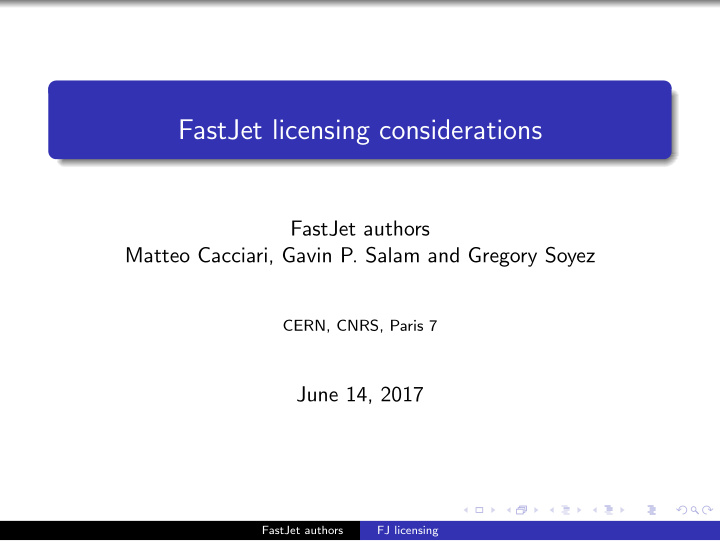



FastJet licensing considerations FastJet authors Matteo Cacciari, Gavin P. Salam and Gregory Soyez CERN, CNRS, Paris 7 June 14, 2017 FastJet authors FJ licensing
FastJet Has been developed continuously since 2005, almost entirely by the 3 of us. Currently licensed GPL(v2), chosen for its copyleft features. Incoporates small fraction of code from 3rd parties (mostly physicists), usually licensed under GPL(v2). In one or two cases, license is unclear, or more permissive. That code can be enabled/disabled at configure-time Some functionality relies on CGAL components (from non-physicists), some licensed under LGPL(v3+), others under GPL(v3+) to protect their commercial rights. This part can be enabled/disabled at configure-time. ATLAS and CMS also use fjcontrib , a library of about 15 3rd-party contributions, released under GPL(v2). Currently we do not have a contributor-licensing agreement (CLA). FastJet authors FJ licensing
MC Guidelines FastJet use is expected to respect the MCNet Guidelines: i.e. if you use it for a scientific publication, you cite it... ����� ��� � � � � �������� � �� � ������ � ����� � ���� �������� � �� � ������ � ����� � ���� �������� � ������ � ������� �������� � ������ � ������� � ��� � ��� � ��� � ��� � ��� � ��� � ��� � ��� � � � � � ���� � ���� � ���� � ���� � ���� � ���� � ���� � ���� � ���� � ���� ���� ���� These guidelines are often not respected FastJet authors FJ licensing
Licensing perspectives We prefer to stay with a copyleft license. GPLv2 is clearly outdated and an update to GPLv3 would be timely. We could envisage “Additional Terms” that specifically allow linking with the ATLAS and CMS frameworks without requiring them to be released under GPL. We hesitate to switch to a more permissive license: we have heard of potential application in biological fields (=commerial) and at that point we clearly need to involve CERN Knowledge Transfer, CNRS, Paris Diderot, UPMC, BNL, Princeton University, FNRS. FastJet authors FJ licensing
Recommend
More recommend